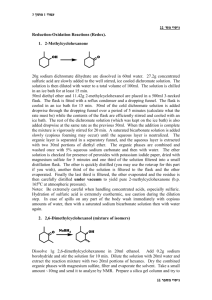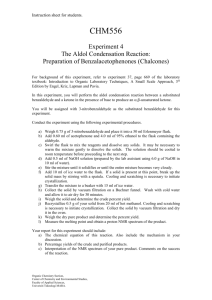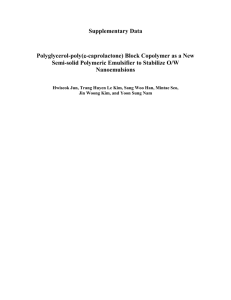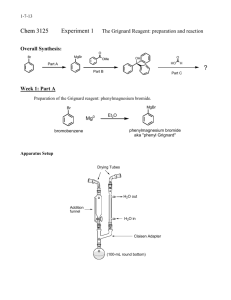Experiment 4. Nucleophilic Sub Reactions. Nucleophilic
advertisement
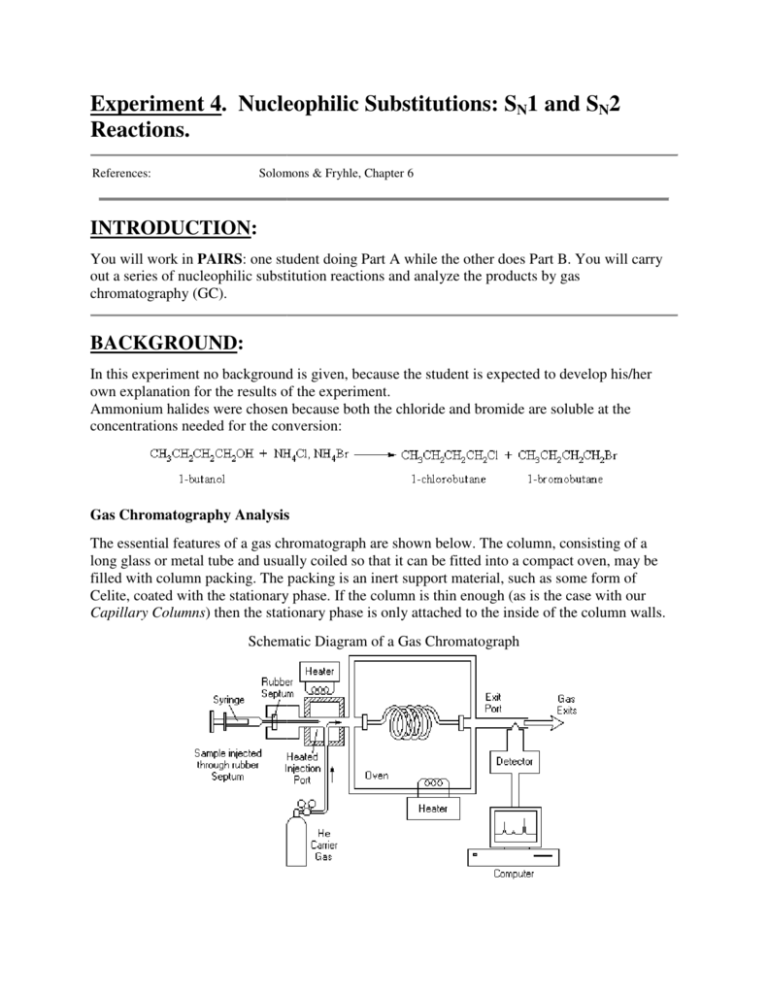
Experiment 4. Nucleophilic Substitutions: SN1 and SN2 Reactions. References: Solomons & Fryhle, Chapter 6 INTRODUCTION: You will work in PAIRS:: one student doing Part A while the other does Part B. You will carry out a series of nucleophilic substitution reactions and analyze the products by gas chromatography (GC). BACKGROUND: In this experiment no background is given, because the student is expected to develop his/her own explanation on for the results of the experiment. Ammonium halides were chosen because both the chloride and bromide are soluble at the concentrations needed for the conversion: Gas Chromatography Analysis The essential features of a gas chromatograph are shown below. The column, consisting of a long glass or metal tube and usually coiled so that it can be fitted into a compact oven, may be filled with column packing. The packing is an inert support material material,, such as some form of Celite, coated with the stationary phase. If the column is thin enough (as is the case with our Capillary Columns)) then the stationary phase is only attached to the inside of the column walls. Schematic Diagram of a Gas Chromatograp Chromatograph The column is mounted in an oven which can be accurately held at any temperature between room temperature and 250oC (usually). The carrier gas (mobile phase) is usually Helium (but sometimes argon, nitrogen, or hydrogen) and passes continuously through the column throughout its operation. A small volume of the mixture to be separated is injected through a rubber septum into the column where it is vapourized, sometimes with the help of a flash heater. The components of the mixture partition themselves between the stationary and mobile phases and move through the column, ideally at different rates, separating into discrete bands. More volatile components are eluted before less volatile compounds, though secondary factors such as polarity may sometimes invert the expected order. The column effluent passes through the detector which senses the separated components as they are eluted and sends an electric signal to the computer. The amount of time that passes after the injection until the compound passes through the column is known as the Retention Time of that compound. PRE-LAB PREPARATION: Read the experimental procedure so that you are prepared for the lab and you understand the safety and disposal information for the chemicals you are using in this experiment. Review substitution reactions and have an idea of what to expect from this experiment. 1. Compare how the following factor affects SN1 and SN2 reaction rates: a) primary vs. tertiary substrates, b) strong vs. weak nucleophiles, and c) nucleophile concentration 2. Is the reaction solvent (not catalyst) in this experiment nonpolar, polar protic or polar aprotic? How does this help or hinder the SN1 and SN2 reactions? 3. Since GC retention times depend on the boiling points (as well as other factors), speculate which halogenated compound (Cl or Br) should elute first from the column? The boiling points of some alkyl halides are listed on p. 223 of your textbook. EXPERIMENTAL PROCEDURE: Work in pairs, one person performs Part A while the other performs Part B. Safety and Disposal Data for Compounds used in the Nucleophilic Substitution Reaction. Compound Ammonium Bromide Mol. Wt. (g/mol) 97.94 Safety and Disposal Data Irritant. Avoid contact with skin and eyes. Ammonium Chloride 53.49 Harmful if swallowed. Irritating to eyes. 1-Butanol 74.12 Flammable. Harmful if swallowed. Irritating to respiratory and skin. Dispose in Halogenated Organic Waste. 2-methyl-2-butanol 88.12 Highly flammable. Harmful by inhalation. Dispose in Halogenated Organic Waste. Sodium Bicarbonate (NaHCO3) 84.00 Avoid contact with skin and eyes. Dispose in Inorganic Bases. 6M Sulfuric Acid 98.07 Corrosive. Causes severe burns. Wear gloves when handling. Dispose in Inorganic Acids and Salts. Equipment Used All the equipment needed to perform this experiment should be in one of the three drawers in the top row of your workstation, one of the drawers underneath your fumehood or the common counter for your TAs group. Part A: Halide Substitution of 1-Butanol. 1. Setting Up your Apparatus a) CAREFULLY: Take 7.5 mL of the concentrated sulfuric acid solution over approx. 10 g crushed ice in a 50 mL roundbottom flask containing a few boiling chips. Clamp your flask securely. b) Through a paper funnel add 2.0 g of ammonium chloride and 3.7 g of ammonium bromide. Unclamp the flask and carefully swirl it around so that the majority of the ammonium salts will dissolve. You do NOT need to wait for your entire mixture to dissolve! Reclamp the flask in position after. The entire set up will work well if you have the heating mantel sitting on a stirrer/hotplate to get it high enough to clamp to the scaffolding, but DO NOT plug in the stirrer/hotplace, it is only being used to lift the setup (see picture). Figure 2: Reflux Setup 2. Refluxing the Reaction Mixture a) If your mixture is not too hot (eg above 30 - 35oC) add 2.7 mL (2.2 g) of 1-butanol slowly to the mixture with stirring. If your mixture is still too warm after 3 - 5 min., cool it slightly with a cold water bath and then add your 1-butanol. b) Add the condenser to the flask, the ground glass joints will come together nicely, no need to force them, but ensure they make a good seal. c) Make sure the whole reaction is clamped straight (vertical). You should use two microclamps, one in the center of the condenser, the other at the top of the roundbottom (see picture). Hook up the condenser to the water supply, the water goes in through the bottom and out the top. Use the thicker tubing for the bottom (the thin tubing doesn’t fit over the green water outlet) and the thin tubing on the top to go down the drain. MAKE SURE the tubing secure. Turn on the water supply (green knob) SLOWLY, so that water is trickling out the exit tubing (you will also see the water flowing through the condenser and out the top). d) Commence heating the reaction mixture by placing the roundbottom (with condenser) in a heating mantle which has been plugged into the VARIAC plug (not the regular outlet). Turn on the heating mantle by turning the VARIAC knob to about 40. To allow for more uniform heating, put some aluminum foil (shiny side in) over the roundbottom and top of heating mantel to seal in the heat. e) Watch carefully: once the solution starts to boil, the vapour will condense and fall back into the vial, known as refluxing. Turn back the voltage a bit and allow the solution to GENTLY reflux for 1 hour. You must control the heating rate so that the vapours rise no more than 1.52.5 cm up into the condenser. 3. Isolating the Alkyl Halides a) Cool the reaction mixture to room temperature in an ice bath by first removing the heating mantel from the flask. When cool, stop the water flow and remove the condenser. b) Add ~15 mL ether, and transfer the entire solution to a separatory funnel (rinse the flask with a small amount of ether to ensure all is transferred to the separatory funnel). Cap the separatory funnel, shake and DEGAS multiple time. Carefully remove the cap and allow the two layers to separate (Refer to Exp 3). You want the upper ether layer. The bottom water layer can be discarded. c) Wash (extract) the ether layer with 15 mL of ice-cold water, again discarding the lower water layer. d) Wash (extract) the ether layer with 15 ml of 5% NaHCO3 solution. Use extra care in this step as CO2 is produced as the remaining acid is neutralized. You WILL need to DEGASS the CO2 from the funnel often to avoid a pressure build up. You will need to degass often at first (after the first up/down motion). Again, discard the bottom layer. e) Transfer the organic layer to a 25 or 50 mL Erlenmeyer flask. Add a couple scoops of anhydrous calcium chloride (this will soak up any residual water left). Swirl about 2 minutes f) Filter the solution using the glass funnel and a folded piece of filter into another Erlenmeyer flask (See picture). To use the filter paper (ensure you use the right size), fold it twice, then open up the center to form a cone to be placed in the glass funnel. Hold down the paper until you start filtering, once it is wet it will stick to the glass on its own. Once the filtering is complete, heat the remaining ether solution slightly on a hot plate to remove some excess ether and make the solution more concentrated (swirl periodically, heat until about 5 mL remains). Seal the vial with parafilm; keep carefully aside until the GC analysis can be evaluated. PART B: Halide Substitution of 2-Methyl-2-Butanol. Carry out the procedure described in Part A, but use 3.2 mL (2.6 g) of 2-methyl-2-butanol in place of 1-butanol (step 2a). When the addition is complete, reflux the solution for 3/4 hour, instead of a full hour (step 2e). The work-up (steps 3 & 4) is the same as described in Part A. 4. GC Analysis (ABB 307) a) You should record the instrument parameters carefully: i.e. the type of column used, column temperature, the Helium flow rate, and the instrument manufacturer's name (this will be written on the board in the GC room). All these data should be recorded on the GC trace print-out (including your name, the date, and what you injected onto the column A or B!). NOTE: You only need a GC trace for the Part YOU performed. b) On your GC trace, work out the retention time, Rt, for each of your peaks and label them, including the solvent peak. c) Measure the relative areas of the 1-chlorobutane and 1-bromobutane (or 2-chloro-2methylbutane and 2-bromo-2-methylbutane) peaks obtained by the chromatographic separation of the mixture. The area of the peak is approximately equal to Area = [(peak height) x (peak width at half-height)]. d) Assume that the molar ratio of the components is equal to the ratio of the area of the peaks and calculate the ratio of 1-chlorobutane : 1-bromobutane. Your GC trace will look similar to the one shown below, and the retention time can be simply read off the bottom of the trace (in minutes) from the middle of the peak of interest. Retention Time (in minutes) 5. Discussion This is the only lab that requires a brief (~1page) discussion section. You will have extra time to work on this lab report. Use the GC trace you obtained, and also do a rough comparison with that of your partners for peak sizes. a) Draw out the complete mechanisms for Part A and B using X- as the halogen. Comment on whether both GC results (A and B) allow you to conclude anything regarding the mechanisms of these reactions (why the difference?) b) Based on both your GC trace and that of your partners (by comparing rough peak areas), comment on whether the results allow you to conclude which is the better nucleophile, chloride or bromide ion in the reaction conditions, and explain why it is better. Note: You have 1 week, starting at the start of this lab period (1:30), to hand in report #4. Hand in the report to your TA at the START of lab 5. With your report, include your GC trace along with a brief discussion and a conclusion. Make sure you include your name, lab section and station number!!!!
